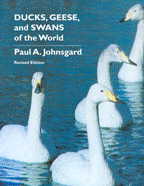Papers in the Biological Sciences
Date of this Version
2010
Abstract
Blue-winged Goose
Andean Goose
Magellan Goose
Kelp Goose
Ashy-headed Sheldgoose
Ruddy-headed Sheldgoose
Orinoco Goose
Egyptian Goose
Ruddy Shelduck
Cape Shelduck
Australian Shelduck
New Zealand Shelduck
Crested Shelduck
Northern (Common) Shelduck
Radjah Shelduck
The most gooselike species of the subfamily Anatinae are the sheldgeese, which together with the closely related shelducks constitute the tribe Tadornini. This group of 14 species has a worldwide distribution except for North America. The typical sheldgeese are grazing birds, the ecological counterparts of the true geese, while the shelducks are mostly wading and dabbling birds, frequently feeding to a large extent on aquatic invertebrates. In all of the species the adult male has an enlarged bony bulla in the syrinx, which is evidently responsible for the whistling or whistlelike sounds that are important in sexual and aggressive displays. The females of all species have more reedy and typically gooselike or ducklike notes. In all species the males are larger than the females, and often differ appreciably from them in plumage. Although pair bonds are sometimes said to be permanent in the group, in some species at least they may be ruptured through interactions with outside males, and a premium is placed on male aggressiveness during sexual competition for mates. The wings are used in fighting and in most species they are strongly patterned, with white coverts and iridescent coloration on the secondaries or their greater coverts. The downy young are also typically patterned contrastingly in the shelducks and sheldgeese, a characteristic shared with various other cavity-nesting waterfowl.


Comments
In Ducks, Geese, and Swans of the World, by Paul A. Johnsgard. Electronic edition copyright © 2010 Paul A. Johnsgard.